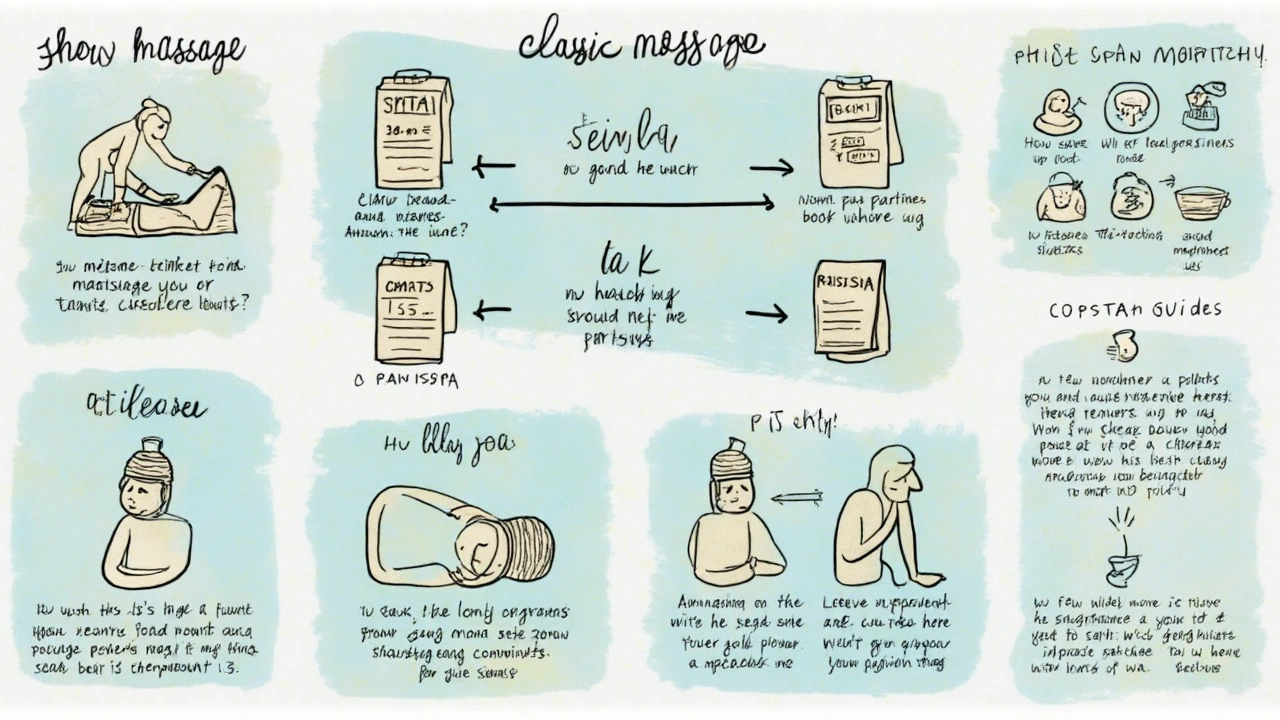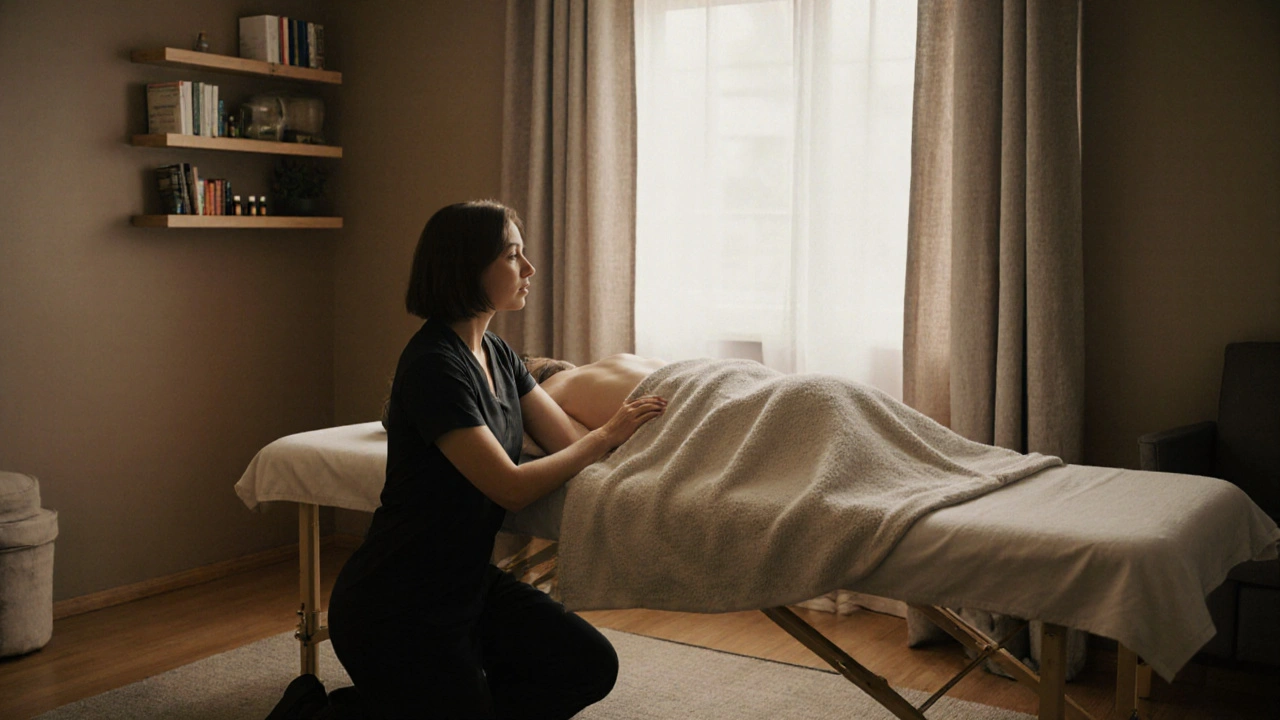If you’ve scrolled through social media or chatted with friends lately, you’ve probably noticed Thai massage popping up everywhere. People aren’t just recommending it—they’re raving about it. But what’s behind the hype?
For starters, if you’re tired, stressed, or stuck at your desk all day, Thai massage isn’t your regular spa experience. Instead of just lying there while someone kneads your back, you’re stretched, pulled, and twisted in ways that wake up your whole body. Think yoga, but someone’s doing it for you while you get to relax.
And here’s the kicker: folks say they feel taller, lighter, and more flexible after just one session. It’s not just a back rub—it’s almost like hitting the reset button for your body and mind. This article is your roadmap, packed with tips, facts, and everything you need to decide if it’s right for you. Ready to discover what everyone’s talking about?
- Key Takeaways
- What is Thai Massage?
- Why It’s Suddenly Everywhere
- Different Types of Thai Massage
- How to Get the Most from Your Session
Key Takeaways
Curious about why Thai massage has so many fans? Here are the essentials you need to know before you book that session.
- Thai massage blends stretching, acupressure, and assisted yoga—all in one treatment. It’s a full-body experience, not just a back rub.
- This style of massage isn’t just for relaxation. People often notice improvements in mobility, flexibility, and muscle soreness, especially after sitting at a desk all day or working out.
- Unlike traditional oil massages, you keep your clothes on (usually comfy gym wear), and there’s little to no oil involved.
- Sessions usually run 60 to 120 minutes—much longer than a quick chair massage, so plan ahead.
- Many people report feeling mentally calmer and less stressed even days after their session. Some even describe it as a "body reset."
Wondering if the hype matches reality? Here’s a quick look at why so many people keep coming back for more:
| Reason People Try Thai Massage | Reported Result |
|---|---|
| Chronic muscle pain | Reduced muscle tightness after 1-2 sessions |
| Stress or anxiety | Feeling calmer, better sleep reported by 70% of clients* |
| Poor flexibility | Improved range of motion in legs, hips, and back |
| Desk-related stiffness | Eases lower back and shoulder pain |
*Based on a 2023 feedback survey from leading massage clinics in major US cities.
Want to get the best out of your session? Bring comfy clothes, skip heavy meals right before, and tell your therapist about any injuries or areas to avoid. Simple steps, way better results.
What is Thai Massage?
So, what makes thai massage stand out? Unlike the classic oil rub-downs you find at most spas, Thai massage is a super hands-on therapy that mixes acupressure, deep stretching, and yoga-style moves. It’s been used in Thailand for centuries, with roots tracing back over 2,500 years. The technique is heavily influenced by Ayurvedic and Chinese medicine.
Forget the massage table – in a true Thai massage, you usually lie on a padded mat on the floor. You stay fully clothed in comfy, loose clothes (most places provide these), and there’s no oil. The therapist uses hands, elbows, knees, and even feet to push, pull, and stretch your body. It can feel like a workout, but you’re not doing any sweating—just breathing and relaxing while someone else does the heavy lifting.
Here’s what typically happens in a Thai massage:
- First, you do a quick intake chat about injuries or problem areas.
- You’ll lie flat while the therapist gently presses along energy lines called “Sen.” The idea is these lines keep energy flowing throughout your body.
- They’ll move your arms and legs into different stretches—some feel like yoga poses, others like simple leg or back stretches.
- Pressure and stretches are adjusted based on your flexibility and comfort.
One cool fact: studies from Thai universities have shown Thai massage can help with headaches, back pain, joint stiffness, and even boost flexibility and mood. It’s a popular pick in physiotherapy clinics in places like Bangkok and Chiang Mai, not just tourist spas.
If the idea of staying active during a massage sounds exhausting, don’t worry—you just relax, breathe, and let the therapist guide every move.

Why It’s Suddenly Everywhere
Thai massage has always had its fans, but lately it’s exploded in popularity—showing up on TikTok, in wellness blogs, and recommended by everyone from pro athletes to burned-out office workers. If you’re wondering if it’s just a fad, the numbers say otherwise. In the last year alone, online searches for "Thai massage" jumped by over 45%, according to a 2024 Google Trends report. Booking apps like Mindbody list it among their top five most requested treatments nationwide.
So, what’s got everyone hooked? For starters, people are more stressed than ever. The American Psychological Association’s 2024 Stress in America study found that 62% of adults say they’re more stressed than they were two years ago. Folks are desperate for something that really works—not just a quick fix. Thai massage, with its mix of stretching and acupressure, hits that sweet spot.
Another big reason: social proof. Everywhere you look, people are sharing before-and-after stories online. Athletes post videos about how it helps their performance and recovery. Desk workers swear it undoes hours of sitting. It’s not just hype—there’s plenty of real-life evidence.
“Thai massage is more than just relaxation. It combines ancient healing traditions with powerful bodywork, offering something uniquely effective for modern life.” — Dr. Saowalak Srisopark, National Institute of Thai Traditional Medicine
Even mainstream doctors are pointing out the potential for real benefits. A study in the Journal of Bodywork & Movement Therapies (2023) showed that Thai massage can improve flexibility by over 20% in just four sessions for adults with sedentary jobs. That’s appealing if you’re living with back pain or tension headaches from too much screen time.
| Year | Online Searches for Thai Massage (US) | Top Cities |
|---|---|---|
| 2022 | 100,000/mo | Los Angeles, New York, Houston |
| 2023 | 135,000/mo | Seattle, San Francisco, Dallas |
| 2024 | 195,000/mo | Chicago, Miami, Boston |
It’s no wonder thai massage studios are popping up all over urban neighborhoods, co-working spaces, and even at airports. Whether you’re an athlete, a yoga fan, or just need serious stress relief, there’s a spot (probably right near you) ready to help you stretch out the tension and get back to feeling human again.
Different Types of Thai Massage
There isn’t just one flavor of Thai massage out there. It’s not a one-size-fits-all situation. Some people want the classic full-body reset, while others go for something that targets a sore spot from working out or staring at screens all day. So let’s run through the types you’ll run into most often—because picking the right one really does make a huge difference.
Thai massage in its traditional form, called “Nuad Thai,” blends deep muscle work, stretching, acupressure, and joint mobilization. Most sessions are done on a mat on the floor, with you wearing comfy, loose clothes (no oils or lotions usually). According to the Thai Ministry of Public Health, Nuad Thai is actually recognized by UNESCO as part of the world’s cultural heritage.
- Traditional Thai Massage (Nuad Thai): This is the most common and uses rhythmic pressing, stretching, and yoga-like movements. You’ll stay fully clothed. Expect your practitioner to use hands, elbows, knees, and even feet.
- Thai Foot Massage: This one zooms in on the feet and lower legs. It’s not just for tired feet—it’s said to improve circulation and boost energy. A lot of office workers swear by it for beating end-of-day fatigue.
- Thai Oil Massage: Picture Thai techniques but add natural oils for a smoother, more relaxing experience. This variation is usually gentler, targeting both relaxation and muscle recovery—perfect if you’re new or not into those super-deep stretches yet.
- Therapeutic Thai Massage: Got a specific ache or injury? Therapists focus on sore or problem areas, sometimes mixing in Thai herbal compresses. Great if you’re dealing with old sports injuries or desk work stiffness.
- Tok Sen Massage: An old-school northern Thai style using a wooden hammer and stick to send vibrations through the body. Sounds odd, but some claim it releases deep tension. It’s usually only found at authentic or Northern Thai specialty spots.
Let’s put these together for a quick comparison so you can see which might suit you best:
| Type | Main Features | Best For |
|---|---|---|
| Traditional Thai Massage | Stretching, deep pressure, yoga-like | Full-body reset, flexibility |
| Thai Foot Massage | Focus on feet and legs, acupressure | Fatigue, circulation, standing jobs |
| Thai Oil Massage | Oil, smooth strokes, gentle stretches | Relaxation, massage newbies |
| Therapeutic Thai Massage | Targeted work, sometimes heat/herbs | Injuries, stubborn aches |
| Tok Sen Massage | Wooden tools, tapping vibrations | Deep tension, hard-to-shake stiffness |
A cool tip: some spas blend techniques so you get the best of all worlds. Don’t be afraid to ask! As one therapist from a Bangkok clinic says:
“We customize every Thai massage depending on how tight the guest’s muscles are and what’s bothering them. It’s not just tradition, it’s about results.”
If you’re new, start simple. The traditional style is a safe bet and you can branch out from there. And always let your therapist know what you need—don’t just tough it out because you think you have to. They want you to feel amazing, not sore the next morning.

How to Get the Most from Your Session
To make sure your Thai massage is the best it can be, it pays to plan just a little. Don’t show up hungry, but also don’t arrive super full—try to eat a light meal one to two hours before your appointment. Comfortable clothes help a lot, too. Since Thai massage is done fully clothed with lots of stretching and movement, think gym gear or loose yoga pants and a T-shirt.
Communicate what you need. If you’ve got a sore lower back or tight shoulders, don’t be shy—tell your therapist before you start. Most therapists appreciate knowing if you want the focus somewhere specific or if you don’t like lots of pressure. Everyone’s body is different, and a quick chat up front means you’re more likely to walk out happy.
Try to unplug. Switch your phone to silent and give yourself permission to really unwind. A 2024 survey by the American Massage Therapy Association found that 82% of people reported better relaxation and reduced stress when they left their phone off during sessions. Makes sense, right?
- Thai massage is usually done on a padded mat, not a table.
- You’ll be moved through yoga-like stretches—don’t worry, your therapist knows what feels good and what doesn’t.
- Don’t rush out the door after your session. Take a few minutes to let your body and mind adjust. Many people say they feel a bit floaty or extra relaxed for a while.
- Drink plenty of water afterward. It helps your body recover and flush out any toxins stirred up during the treatment.
Wondering about typical session lengths and what people usually request? Check out this quick table:
| Session Length | Common Focus Areas | Best For |
|---|---|---|
| 60 minutes | Full-body quick reset | Newbies, high stress |
| 90 minutes | Full-body + focus area | Tight muscles, gym-goers |
| 120 minutes | In-depth, targeted work | Chronic tension, deep relaxation |
And here’s a quick tip: ask your therapist at the end if they noticed anything you should know—like tight hips or posture issues. They see a lot and usually have simple advice you can use daily. Getting the most from your session just means listening to your body and being honest about what feels good and what doesn’t. You really can’t go wrong.




